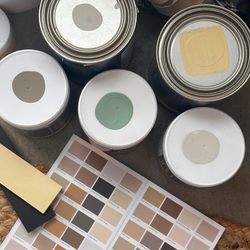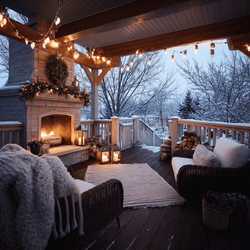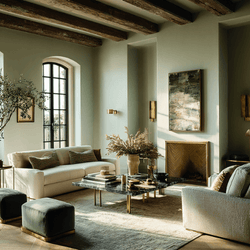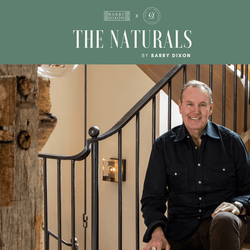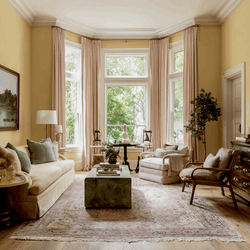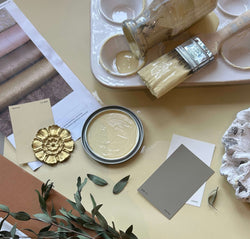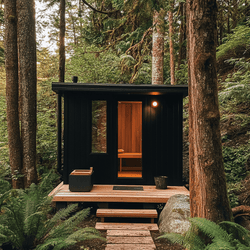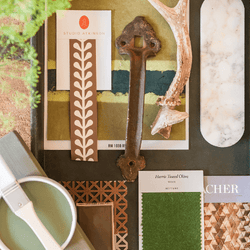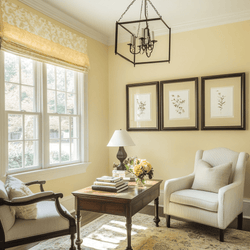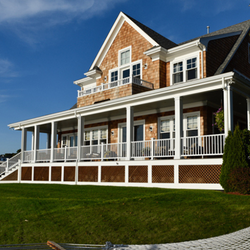The Golden Triangle and The Styling Magic of Three
As a stylist, I am constantly aware of my everyday surroundings, keeping a watchful eye for something that strikes me as interesting, unusual, or simply beautiful – even in the most ordinary moments. The art of styling requires practice, patience, props (the more variety, the better!), a sense of curiosity, and a few foundational rules.
#1: The Golden Triangle: Nature's Visual Guide

In terms of technical know-how, consider using what is known as "The Golden Triangle," a mathematical ratio found in nature that works according to the rule of thirds.
The same ratio applies to interior decorating when you mentally divide a space/image into thirds both horizontally and vertically. Positioning the focal point at the points where they meet (they can be slightly asymmetrical), helps guide the eye rather than directing attention to the center, where the eye tends to naturally gravitate.
TIP: You can pull the grid up on your phone when taking a photo as a good point of reference as you familiarise yourself with this ratio. (just turn the gridlines on in your Settings).
Styling is a way to communicate an idea of something we love, an opportunity to reuse things we have in new ways and add new where needed. Here’s how to get started:
- Gather your favourite objects is all part of the process. This quest brings further ideas and inspiration. When I'm in the 'gathering' mode, I consider textures, harmonizing colours, size, and shapes that relate.
- Create small groups of the same object: like plates or small framed photos, can be mounted and displayed as a substantial group for a more significant impact.
- If it's an open shelf concept, you do not have to fill the entire shelf length by any means—group items in clusters of 3s making sure to pay attention to the height of an upper shelf. I like to use books that are uniform in colour and size and place a vase on top or to one side. It's an easy way to dress up a hallway bench seat.
- If its a tabletop or buffet, I will always add a branch of blossom or greenery to give height and house it in an attractive container.
Being surrounded by lovely things is part of what makes us feel good. Create areas with a sense of balance and scale, colour, and textural diversity.
- Don't overload - even if you love a piece it might not be right for this staging concept so put it aside
- Take lots of photos to see what works and what does not. Looking at your work through the lens is the best way to be objective.
- Add greenery. Foliage adds a touch of nature, which adds colour and texture to any styling. It's always that beautiful finishing touch that seems to bring it all together.
#2 The Rule of 3: The Secret Behind Smart Styling

Did you know that items that are grouped in odd numbers are naturally more appealing to the eye? When you have a mix of objects you want to use to create a visual story, arrange them in three's (which I always think of as the 3 I's - imagine, intuit and implement). Otherwise, they don't feel engaging when they're all lined up like soldiers. Instead, imagine you're creating a multi-dimensional triangle. One object should be taller, another should sit lower and forward, and a third should sit somewhere in-between both in terms of height and width. This is an accessible compositional guideline within photography that we use when styling.
#3 The Triangle of Reason: The Secret to a Successful Kitchen

Set up your kitchen for optimal workflow by using -- you guessed it -- a triangle. The three main work areas - the sink, stove, and refrigerator - should all form a triangle to optimize your workflow.
The main goal of the triangle is efficiency. It keeps all the major work stations near the cook without placing them so close that the kitchen becomes cramped. The work triangle is also designed to minimize traffic within this critical kitchen zone so the cook won't be interrupted (safety and sanity) or interfered with.
It's a designated area for one when in operation in my household - anyone else can sit across the island and socialize! If the kitchen has only one sink, it should be placed between or across from the cooking surface, preparation area, or refrigerator. (kitchens.com)Ideally, it meets the newer boutique 'work station' sink stations with strainers, cutting boards, etc. like KRAUS Kore 45" workstation.
FUN FACT



